For many parents, the Louvre is the final frontier. Its size, the crowds and the fear that children will be bored can be discouraging. But an outing to the Louvre can be great fun for child and parent. The key is diligent planning.
Pierre Salinger Remembers
Pierre Salinger was in town last month to promote his new book: “P.S. A Memoir,” published simultaneously in French and English. Happily, the event coincided with the 100th anniversary of Brentano’s bookstore, so the passage of some 30 million books and the publication of one new one were duly celebrated by a literary lunch at the Hotel Bristol on October 11, and an extremely successful book-signing at Brentano’s on the 14th. The dual publication is fitting for a man who has spent so much of his life in France and has been known to the French public as a kind of “voice of America” ever since he conducted a Kennedy press conference over 30 years ago and wowed the local press boys by addressing them in French.
Remembering Montparnasse’s Art Scene
In the early decades of the century, Montparnasse – named after the mountain home of Apollo and the muses – saw a concentration of artistic talent so vibrant that the quarter’s myth came to rival that of its ancient namesake. Struggling young painters and sculptors from all over the world were drawn to its ateliers. At dusk they filled the cafés, cadging drinks and boasting. If they were flush, they moved on to headier pleasures like a Dadaist play, a fancy-dress ball or a raucous supper at the Closerie de Lilas. But with World War II, the feast moved on, and today the neighborhood holds only echoes of old glory. Those seeking the essence of the 14th arrondissement will have better luck in the 7th, at the Espace Electra’s excellent “Les Heures Chaudes de Montparnasse.” Continue reading “Remembering Montparnasse’s Art Scene”
Merry Month of May Getaways
Long days, mild weather and an army of jours fériés make May ideal for weekend trips into France’s far-flung corners. Between May Day, Ascension, V-E Day and associated “ponts,” this month was made for weekend forays. May is also a spectacular month to see France in bloom – fields of brilliant yellow rapeseed plants grace the countryside from Calais to Lyon.
Sugar Blue’s Paris Blues
I know it’s dumb but I can’t help asking: is it true that Mick Jagger first spotted Sugar Blue playing harmonica on the Métro? Sugar Blue looks at me like it’s the sorriest question he’s ever heard. “Oh man,” he says, “can you really imagine Mick Jagger on the Métro…? I mean, they’d never let him out!” Okay, so how did he wind up playing fierce harp solos on tracks like “Miss You” for three of the Stones’ best albums? “I was jamming at a party in Paris when this guy gives me a number to ring about some session work. This English voice answered and said it was Mick, and told me to come on over to the studio, only it was like midnight or something, but I went. The taxi put me out at this deserted place near the Bois and just when I was thinking I was out of my mind for believing this stuff, someone opens a door and the next thing you know I’m recording with the Stones!”
Paris, a Day at the Races
Although no “Hemingway sat here” plaques adorn the grand-stands of the eight Paris racetracks, the American writer was a regular horseplayer when he lived here from 1921 to 1926. Since the French racing establishment has done little or nothing to attract tourism – not even one brochure at tourist information centers – racing is one of Paris’ best kept entertainment secrets.
Web Future Gazing in 1995
In 1969, when many of us were watching the flag-waving Archie Bunker chew out the Meathead, his lazy, pinko, long-haired son-in-law, the United States government was secretly putting in place a small but innovative network of four computers that would share information and be impermeable to Soviet attack.
Fashion Photographer Sarah Moon
Paris Fashion in an Uproar
Robert Altman has Paris fashion in an uproar. Feeling used, abused and terribly misrepresented, industry professionals are screaming “foul play” over the film “Prêt-à-Porter.” “We are portrayed as a class of sex-crazed, dishonest, bubble brained idiots,” designer Jean-Charles de Castelbajac told Paris Match.
Doris Lessing “Under My Skin”
Doris Lessing likens memory to a shut door – the one that Alice desperately seeks to open though she is too small reach the doorknob. The access she has to her own past is unsure, arbitrary, selective. She describes as “creepy” the phenomenon that, “what I was told and what I remember were not the same.” She seemed to debate with herself, in the presence of a rapt audience at the British Council, the very nature of autobiography.
Trailing Spouses… and Careers
Spouse trailing is the curse of the expatriate wife, but Catherine Gilson turned it into a blessing by transforming her volunteer experience in Paris into The Culture Club, her own tour group. She is a textbook example of how women square the sometimes vicious circle of moving, setting up a household and trying to establish themselves before moving on again – the subject of a career-development seminar last month organized by WICE and the American University of Paris.


